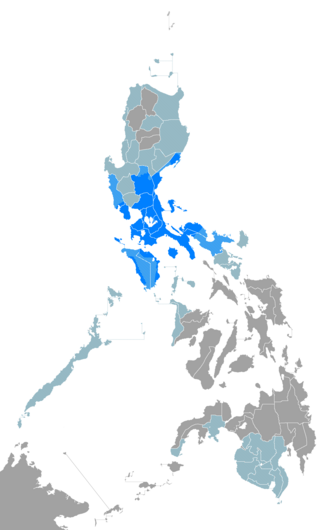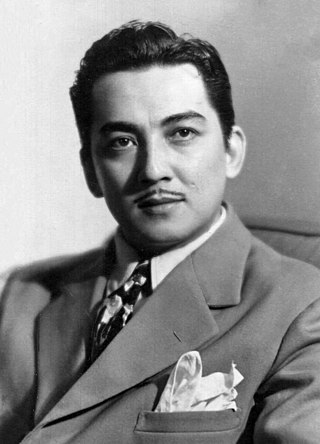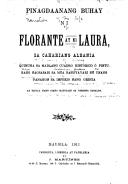
Tagalog is an Austronesian language spoken as a first language by the ethnic Tagalog people, who make up a quarter of the population of the Philippines, and as a second language by the majority. Its standardized form, officially named Filipino, is the national language of the Philippines, and is one of two official languages, alongside English.

Francisco Balagtas y de la Cruz, commonly known as Francisco Balagtas and also as Francisco Baltasar, was a Filipino poet and litterateur of the Tagalog language during the Spanish rule of the Philippines. He is widely considered one of the greatest Filipino literary laureates for his impact on Filipino literature. The famous epic Florante at Laura is regarded as his defining work.

Pilar Garrido Corrales is a Filipino pop singer, songwriter, actress, comedian and television presenter. She is best-known for her distinctive backbend when singing and is popularly referred to as the "Asia's Queen of Songs" for her vocal style and longevity.
Lakandula was the title of the last lakan or paramount ruler of pre-colonial Tondo when the Spaniards first conquered the lands of the Pasig River delta in the Philippines in the 1570s.

Ibong Adarna, also known as The Adarna Bird, is an early 19th-century Filipino epic poem that centers around a magical bird of the same name. During the Spanish era, the longer form of the story's title was Korido at Buhay na Pinagdaanan ng Tatlong Prinsipeng Magkakapatid na anak ni Haring Fernando at ni Reyna Valeriana sa Kahariang Berbanya. Some researchers suggest that the tale may have been influenced by similar European stories.
José de la Cruz, more popularly known as Huseng Sisiw, was one of the great Tagalog writers during the Spanish colonization of the Philippines.

Regidor Lim de la Rosa, professionally known as Rogelio de la Rosa, was one of the most popular Filipino matinee idols of the 20th century. He is also remembered for his statesmanship, in particular his accomplishments as a diplomat. Elected to the Philippine Senate from 1957 to 1963, he was the first Filipino film actor to parlay his fame into a substantial political career, paving the way for other future Filipino entertainers-turned-politicians such as Senators Ramon Revilla Sr., Tito Sotto, Ramon "Bong" Revilla Jr., Jinggoy Estrada, Lito Lapid, Freddie Webb, Robin Padilla, and President Joseph Estrada.
The 39th Don Carlos Palanca Memorial Awards for Literature was held to commemorate the memory of Don Carlos Palanca Sr. through an endeavor that would promote education and culture in the country. This year saw the inclusion of a new category, Short Story for Children/Maikling Kwentong Pambata, for both the English and Filipino Divisions.
Florentino Collantes was a Filipino poet who was among the writers who spearheaded a revival of interest in Tagalog literature in the Philippines in the 20th century.
Rene O. Villanueva was a Filipino playwright and author. He is famed for his deep involvement in theater and television and in children's literature, whether it be on television, in books or on stage.
Lamberto E. Antonio is a Filipino writer.
Alejandro G. Abadilla, commonly known as AGA, was a Filipino poet, essayist, and fiction writer. Critic Pedro Ricarte referred to Abadilla as the father of modern Philippine poetry, and was known for challenging established forms and literature's "excessive romanticism and emphasis on rhyme and meter". Abadilla helped found the Kapisanang Panitikan in 1935 and edited a magazine called Panitikan. His Ako ang Daigdig collection of poems is one of his better-known works.
"Sa Aking Mga Kabatà" is a poem about the love of one's native language written in Tagalog. It is widely attributed to the Filipino national hero José Rizal, who supposedly wrote it in 1868 at the age of eight. There is not enough evidence, however, to support authorship by Rizal and several historians now believe it to be a hoax.
Efren Reyes Abueg is a well-known and recognized Filipino-language creative writer, editor, author, novelist, short story writer, essayist, fictionist, professor, textbook writer, and anthologist in the Philippines. His works appeared on magazines such as Liwayway, Bulaklak, Tagumpay, Mod, and Homelife.
The awit is a type of Filipino poem, consisting of 12-syllable quatrains. It follows the pattern of rhyming stanzas established in the Philippine epic Pasyon. It is similar in form to the corrido.

Hermenegildo Cruz (1880–1943) was a Filipino writer and prominent trade union organizer.
Lázaro Francisco y Angeles, also known as Lazaro A. Francisco was a Filipino novelist, essayist and playwright. Francisco was posthumously named a National Artist of the Philippines for Literature in 2009.

Noel Gadiano Cabangon is a Filipino folk singer and composer, known for composing socially-relevant songs. In 1987, he formed the group Buklod together with Rene Boncocan and Rom Dongeto.
Malvar: Tuloy ang Laban is an upcoming Filipino biographical war film directed by Jose "Kaka" Balagtas and written by Ed Samson. It will depict the life of Miguel Malvar, one of the last Filipino generals to surrender in the Philippine–American War. The film will star Manny Pacquiao as the titular General Malvar, with Isko Moreno as Andrés Bonifacio and E.R. Ejercito as Emilio Aguinaldo.







